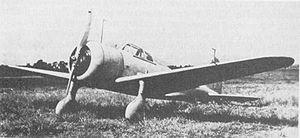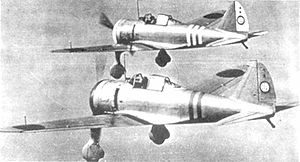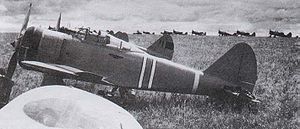Nakajima Ki-27 Video - Overview - Japanese
|
|
Nakajima Ki-27
Nakajima Ki-27

Picture - Nakajima Ki-27
Role: Fighter aircraft
Manufacturer: Nakajima Aircraft Company
First flight: 15 October 1936
Introduced: 1937
Retired: 1945 (Japan)
Primary users: Imperial Japanese Army Air Force
Manchukuo Air Force
Royal Thai Air Force
Reformed Government of the Republic of China
Number built: 3,368

Picture - Nakajima Ki-27 of the Akeno Army Flying School, ca. winter 1941/42 (see Bueschel 1970).
The Nakajima Ki-27 (ä¹ä¸å¼æ¦éæ© , KyÅ«nana-shiki sentÅki, or Type 97 Fighter) was the main fighter aircraft used by the Imperial Japanese Army Air Force up until 1940. Its Allied nickname was "Nate", although it was called "Abdul" in the "China Burma India" (CBI) theater by many post war sources; Allied Intelligence had reserved that name for the nonexistent Mitsubishi Navy Type 97 fighter, expected to be the successor to the Type 96 carrier-borne A5M with retractable landing gear and an enclosed cockpit.
Design and development
In 1935, the Imperial Japanese Army held a competition between Nakajima, Mitsubishi, and Kawasaki to design a low-wing monoplane to replace the Kawasaki Ki-10 (Army Type 95 Fighter) biplane. The new fighter was to have also a better performance than the experimental Mitsubishi Ki-18.
The results were the Nakajima Ki-27, the Kawasaki Ki-28, and the Mitsubishi Ki-33 (a modification of the Mitsubishi A5M carrier-based fighter). The Nakajima design was based on its earlier Ki-11 monoplane fighter which lost to the Ki-10 in the Type 95 Fighter competition. When the follow-up Nakajima Ki-12 proposal with a liquid-cooled engine and retractable landing gear was deemed too complex by the Japanese officials, the Ki-27 was designed by Koyama Yasushi to have an air-cooled radial engine and fixed landing gear. The aircraft had the Nakajima trademark wing with a straight leading edge and tapered trailing edge which would reappear again on the Ki-43, Ki-44, and Ki-84.
The Ki-27 made its first flight on 15 October 1936. Although it had a slower top speed and worse climb performance than its competitors, the Army chose the Nakajima design for its outstanding turning ability granted by its remarkably low wing loading. The Army ordered 10 pre-production samples (Ki-27a) for further testing, which featured an enclosed cockpit with sliding canopy and larger wings.
The type was officially accepted into service in 1937 as the Army Type 97 Fighter. In addition to Nakajima, the Ki-27 was also manufactured by Tachikawa Aircraft Company Ltd and Manshukoku Hikoki Seizo KK, with a total of 3,368 built before production ended in 1942.
Operational history
The Ki-27 was the Imperial Japanese Army Air Force's main fighter until the start of World War II. When placed into combat service over northern China in March 1938, the Ki-27 enjoyed air superiority until the introduction of the faster Soviet-built Polikarpov I-16 fighters by the Chinese.

Picture - A Ki-27 as used in the Battle of Khalkhin Gol.
In the 1939 Battle of Khalkhin Gol against the USSR in Mongolia, the Ki-27 faced both Polikarpov I-15 biplane and the I-16 monoplane fighters. In the initial phase of the conflict, its performance was a match for the early I-16 models it faced, and considerably superior to the I-15 biplane. With clearly better trained and experienced Ki-27 pilots, the IJAAF gained aerial superiority. The deficiencies of the Ki-27 included a lack of armor protection for the pilot, absence of self-sealing or fire suppression in the fuel tanks and inadequate armament of two 7.7 mm (.303 in) machine guns. Despite these faults, whenever Ki-27s managed to scatter an enemy formation and engage in dogfights, the Soviets had little chance of escaping unscathed.
Later the Soviet Air Force started to receive improved and new types including an improved I-16. The faster, more heavily armed, armored and more robust I-16 proved to be superior to the Ki-27. The new I-16 also allowed Soviet pilots to routinely escape from the Ki-27 in a dive. The VVS started to use new combat tactics consisting of flying in large tightly knit formations, attacking with altitude and/or speed advantage, and hit-and-run (high-energy) tactics. Consequently, as Japanese pilots began to be exhausted by the strain of constant combat, losses soon became heavy, and as a result, in spite of the Ki-27's excellent maneuverability and early performance, the Japanese claim of 1,252 downed enemy aircraft (six times the official Soviet losses number and three times as high as the actual number of committed Soviet aircraft in total) is clearly unrealistic. Top scoring pilot of the incident and top scoring IJAAF pilot on the Ki-27 and overall WW2 IJAAF ace was Warrant Officer Hiromichi Shinohara, who claimed 58 Soviet planes (including a IJAAF record of 11 in one day) whilst flying Ki-27s, only to be shot down himself by a number of I-16s on 27 August 1939.
The preference of Japanese fighter pilots of the Ki-27's high rate of turn caused the Army to focus almost exclusively on maneuverability, a decision which came back to haunt them later as it handicapped the development of faster and more heavily-armed fighters. The Ki-27 served until the beginning of World War II in the Pacific, escorting bombers attacking Malaya, Singapore, Netherlands East Indies, Burma and the Philippines (where it initially fared poorly against the Brewster Buffalo).
The type also saw extensive action against the American Volunteer Group in the early months of the war. Soon outclassed by the American Curtiss P-40s, the Ki-27 was replaced in front line service by the Nakajima Ki-43, with surviving examples continued to serve as a trainer.
The Ki-27 was also exported for use with Manchukuo and Thai armed forces, seeing combat with both. In Thai service, Ki-27s reportedly damaged two P-51 Mustangs and shot down one P-38 Lightning. Near the end of World War II, a few Ki-27s were equipped with up to 500 kg (1,100 lb) of explosives for a kamikaze role.
Variants
Data from
Nakajima Type PE -
Private-venture experimental aircraft with Nakajima Ha.1a engine.
Nakajima Ki-27
Prototype version with armament in response to IJAAF specs, two aircraft built.
Nakajima Ki-27-Kai Prototype
Pre-production units with armament and heavier Ha.1b engine, 10 aircraft built.
Ki-27a (Army Type 97 Fighter)
First production version. Approximately 565 aircraft built.
Ki-27a-Kai
Trainer version converted from existing production. Approximately 150 aircraft converted.
Ki-27b (Army Type 97b Fighter)
Improved version with an improved canopy, oil cooler and provision for 4 x 25 kg (55 lb) bombs or fuel tanks under the wings. A total of 1,492 built, including 50 by Tachikawa Aircraft Company Ltd.
Ki-27b-Kai
Trainer version converted from existing production. Approximately 225 aircraft converted.
Nakajima Ki-27-Kai
Experimental lightened version developed as an interim solution when Ki-43 development was delayed, top speed 475 km/h (295 mph); two aircraft built).
Mansyu Ki-79
Trainer version, built by ManshÅ«koku HikÅki Seizo KK with a 510 hp Hitachi Ha.13a-I or Ha.13a-III engine. A total of 1,329 aircraft built in four sub-versions (The single seat Ki-79a (Ha.13a-I) and Ki-79c (Ha.13a-III) and the two-seat Ki-79b (Ha.13a-I) and Ki-79d (Ha.13a-III)).
Operators
World War II
Japan
Imperial Japanese Army Air Force
No. 2 Dokuritsu HikÅ Daitai IJAAF
No. 9 Dokuritsu HikÅ Chutai IJAAF
No. 10 Dokuritsu HikÅ Chutai IJAAF
No. 84 Dokuritsu HikÅ Chutai IJAAF
No. 102 Dokuritsu HikÅ Chutai IJAAF
No. 1 HikÅ Sentai IJAAF
No. 2 HikÅ Sentai IJAAF
No. 4 HikÅ Sentai IJAAF
No. 5 HikÅ Sentai IJAAF
No. 9 HikÅ Sentai IJAAF
No. 11 HikÅ Sentai IJAAF
No. 13 HikÅ Sentai IJAAF
No. 18 HikÅ Sentai IJAAF
No. 21 HikÅ Sentai IJAAF
No. 24 HikÅ Sentai IJAAF
No. 26 HikÅ Sentai IJAAF
No. 29 HikÅ Sentai IJAAF
No. 30 HikÅ Sentai IJAAF
No. 33 HikÅ Sentai IJAAF
No. 48 HikÅ Sentai IJAAF
No. 50 HikÅ Sentai IJAAF
No. 54 HikÅ Sentai IJAAF
No. 59 HikÅ Sentai IJAAF
No. 63 HikÅ Sentai IJAAF
No. 64 HikÅ Sentai IJAAF
No. 68 HikÅ Sentai IJAAF
No. 70 HikÅ Sentai IJAAF
No. 77 HikÅ Sentai IJAAF
No. 78 HikÅ Sentai IJAAF
No. 85 HikÅ Sentai IJAAF
No. 87 HikÅ Sentai IJAAF
No. 101 HikÅ Sentai IJAAF
No. 144 HikÅ Sentai IJAAF
No. 204 HikÅ Sentai IJAAF
No. 206 HikÅ Sentai IJAAF
No. 244 HikÅ Sentai IJAAF
No. 246 HikÅ Sentai IJAAF
No. 248 HikÅ Sentai IJAAF
Rikugun Koukuu Shikan GakkÅ
Tokorozawa Rikugun Koku Seibi GakkÅ
Akeno Rikugun HikÅ GakkÅ
Kumagaya Rikugun HikÅ GakkÅ
Tachiarai Rikugun HikÅ GakkÅ
Manchukuo
Manchukuo Air Force
Reformed Government of the Republic of China
Scheduled aircraft never delivered due to distrust of Chinese forces
Thailand
Royal Thai Air Force
Foong Bin Khap Lai 15 (15 Fighter Squadron)
Foong Bin Khap Lai 16 (16 Fighter Squadron)
Post-War
China
People's Liberation Army Air Force
China
Republic of China Air Force
Indonesia
In 1945, Indonesian People's Security Force (IPSF) (Indonesian pro-independence guerrillas) captured a small number of aircraft at numerous Japanese air bases, including Bugis Air Base in Malang (repatriated 18 September 1945). Most aircraft were destroyed in military conflicts between the Netherlands and the newly proclaimed-Republic of Indonesia during the Indonesian National Revolution of 1945-1949.
Survivors
One Ki-27 is preserved at the Tachiarai Peace Memorial Museum.
One Mansyu Ki-79 is preserved at the Satria Mandala Armed Forces Museum, Jakarta, Indonesia.
Specifications (Ki-27b)
Data from "Nakajima Ki-27 Nate"
General characteristics
Crew: one, pilot
Length: 7.53 m (24 ft 8 in)
Wingspan: 11.31 m (37 ft 1¼ in)
Height: 3.28 m (10 ft 8 in)
Wing area: 18.56 m² (199.777 ft²)
Empty weight: 1,110 kg (2,588 lb)
Loaded weight: 1,547 kg (3,523 lb)
Max takeoff weight: 1,790 kg (3,946 lb)
Powerplant: 1x Nakajima Ha-1 Otsu air-cooled radial engine, 485 kW (650 hp)
Performance
Maximum speed: 470 km/h (275 mph)
Cruise speed: 350 km/h (218 mph)
Range: 627 km (390 mi)
Service ceiling: 12,250 m (32,940 ft)
Rate of climb: 15.3 m/s (3,010 ft/min)
Wing loading: 83.35 kg/m² (18 lb/ft²)
Power/mass: 0.30 kW/kg (0.18 hp/lb)
Armament
Guns: 2 x 7.7 mm Type 89 machine guns, 500 rounds/gun or 1 x 12.7 machine gun and 1 x 7.7 machine gun on later models
Bombs: 100 kg (220 lbs)
Related development
Nakajima Ki-11
Nakajima Ki-12
Nakajima Ki-43
Comparable aircraft
Fokker D.XXI
Polikarpov I-16
Seversky P-35
Bibliography
Bueschel, Richard M. Nakajima Ki.27A-B Manshu Ki.79A-B in Japanese Army Air Force-Manchoukuo-IPSF-RACAF-PLAAF & CAF Service. Reading, Berkshire, UK: Osprey Publications, 1970. ISBN 0-85045-020-9.
Francillon, Ph.D., René J. Japanese Aircraft of the Pacific War. London: Putnam & Company, 1970 (Second edition 1979). ISBN 0-370-30251-6.
Green, William. Warplanes of the Second World War, Volume Three: Fighters. London: Macdonald & Co. (Publishers) Ltd., 1961 (seventh impression 1973). ISBN 0-356-01447-9.
Green, William and Gordon Swanborough. "The Agile Asian... Japan's Type 97 Fighter". AirEnthusiast Six March-June 1978. Bromley, Kent, UK: Pilot Press Ltd., 1978.
Green, William and Gordon Swanborough. WW2 Aircraft Fact Files: Japanese Army Fighters, part 2. London: Macdonald and Janes's, 1977. ISBN 0-354-01068-9.
Januszewski, Tadeusz. Mitsubishi A5M Claude. Sandomierz, Poland/Redbourn, UK: Mushroom Model Publications, 2003. ISBN 83-917178-0-1.
Mikesh, Robert. Japanese Aircraft 1910-1941. Annapolis, MD: Naval Institute Press, 1990. ISBN 1557505632.
Sakaida, Henry. Japanese Army Air Force Aces, 1937-45. Botley, Oxford, UK: Osprey Publishing, 1997. ISBN 1-85532-529-2.
Tapasanan, Vidya. "Japanese Airplanes in the Royal Thai Airforce (RTAF) Service" Asahi Journal No. 4/2002
Thorpe, Donald W. Japanese Army Air Force Camouflage and Markings World War II. Fallbrook, CA: Aero Publishers, Inc.,1968. ISBN 0-8168-6579-5.
Wieliczko, Leszek A. and Zygmunt Szeremeta. Nakajima Ki 27 Nate (bilingual Polish/English). Lublin, Poland: Kagero, 2004. ISBN 83-89088-51-7.
Nakajima Ki-27 Pictures
Living Warbirds: The best warbirds DVD series.
Source: WikiPedia